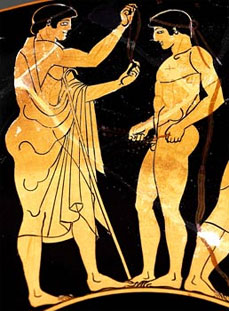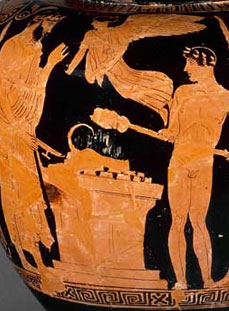

Panathenaic Festival - Historical Background
Like the ancient Olympics, the Grand Panathenaic festival grew and changed over the course of many centuries. Evidence for its history and development comes from inscriptions and classical authors such as Pindar, the poet of victory odes, as well as from works of art, such as the prize amphoras and the Ionic frieze of the Parthenon, and archaeological excavations. The traditional founding date of the Panathenaic games is 566 B.C., but the festival is clearly much older. Perhaps as early as the 8th century B.C., and probably under the influence of the games at Olympia held in honor of Zeus (traditionally dated 776 B.C.), the festival of Athena incorporated a program of athletic and equestrian competitions. These contests no doubt resembled those of the funeral games for the warrior Patroklos described in the Iliad (Book 23), featuring skills that were demanded in warfare such as running and hurling the javelin. Vase-painting evidence suggests that musical contests, which were part of the Pythian games in honor of Apollo at Delphi, also were held at the Panathenaia at an early date.
In the later 6th century B.C., Hipparchos, the younger son of Peisistratos, tyrant of Athens, embellished the festival with the recitation of the Iliad and the Odyssey by professional rhapsodes; every contestant was required to begin where his predecessor stopped so that each lengthy poem was performed in its proper sequence. The works of Homer were recognized as a national treasure by all Greeks, so their appropriation by Hipparchos was an inspired bit of larceny worthy of a statesman who, like his father, wished to promote his city as the political and cultural leader of Greece.
Also during this period, a ten-meter-wide ramp leading up to the west entrance of the Acropolis was constructed. Its purpose could have been only ceremonial, that is, to make the approach to the sacred precinct possible for large processions such as those associated with the Panathenaea.
The most famous Athenian statesman, Pericles, contributed to the development of this festival as well. In 442 B.C. he was selected to be an athlothetes, or supervisor of the contests. He had a particular interest in the musical competitions and is credited with building a concert hall, or odeion, on the south slope of the Acropolis adjacent to the Theater of Dionysos. It was during Perikles' rule that the major building campaign on the Acropolis began. The remarkable Ionic frieze of the Parthenon, with its 378 figures sculpted in low relief, documents many aspects of the Panathenaic procession and its culminating ceremony, the presentation of a new robe (peplos) for the venerable olive-wood cult statue of Athena Polias that was housed in the Ionic temple known as the Erechtheion.
In the Hellenistic period the prestige and allure of the Panathenaic games may have been at their highest. Inscriptions listing the winners indicate that the games attracted participants from as far away as Massalia (Marseilles) and what is Baghdad today. Even royalty found the competitions worthy of their participation. In the first half of the and century B.C., King Eumenes II of Pergamon and his brother Attalos, as well as Queen Kleopatra II of Egypt and her brother and consort King Ptolemy VI, were winners in the equestrian events. The festival appears to have been celebrated until early in the 5th century of our era, at which time all pagan ceremonies were decreed illegal.
